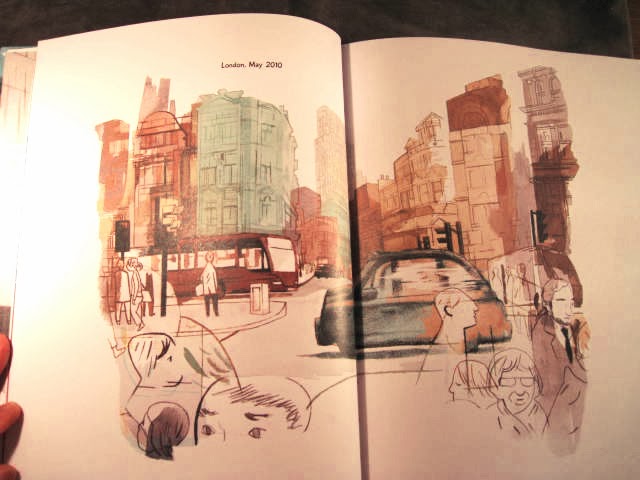This book unfolds slowly, like the controlled movements of a
martial artist’s hand cutting through the air. Just So Happens, by Fumio
Obata, centers on a young Japanese woman who has made a home for herself in
London. After her father’s sudden death, she must return home to Japan and
attend his funeral. Surprised by her own stoicism, she goes through the funeral
ceremony with a critical eye. The chanting holds no significance to anyone at
the funeral, yet everyone goes along with it for the sake of tradition. Holy Buddhist
names can be given to deceased relatives, a practice known as kaimyo. The names
come with different ranks and different price tags. It all seems very
artificial to Yumiko, who’s assimilated somewhat to life in London. She must
find a way to make peace with her father in a way that doesn’t feel staged.
I love the gentle water colors in this book. A double-page spread
of a London street reveals layers of water color, perhaps to show the
transparency and openness of Londoners. Later in the book, there’s a very stiff,
opaque rendering of the funeral home in Japan, revealing the very different
moods each setting inspires in the artist.
Fumio Obata stitches together snippets of dialogue, memory,
dreams, and imaginings from Yumiko’s life. An artist of inferior skill might
try something annoying to indicate they are skipping around in time or
switching from reality to a dream sequence. They might alter their drawing
style completely. For example, all childhood memories are stick figures and
everything in the present is drawn realistically. Fumio Obata does something
very subtle. He just inserts a drawing of a bullet train or a canal or some
other type of scenery. The subtle alteration sends a signal to the reader’s
brain that, okay, we’re daydreaming now, or whatever the case may be.
Just So Happens is now one of my favorite graphic
novels. My enjoyment was magnified since my fascination with Japan is at an
all-time high. (Thanks to Miyazaki movies.) But I suppose if I look way back,
my interest in Japan was tangible when I used to wear a kimono to school. My
mother pointed out that when she was pregnant with me, she was learning
Japanese and taking tea ceremony training, so maybe my contact with Japanese
culture as a fetus had an effect on the type of adult I have become.



No comments:
Post a Comment